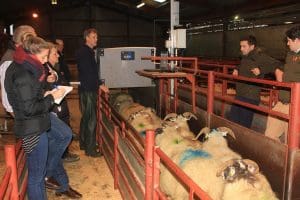
Sheep being scanned through a race reader at the Longtown Market in the UK.
VICTORIA’S saleyards will be on a tight timetable to start scanning electronically tagged sheep and goats by a July 1 2017 deadline set by the state government.
The Victorian-based Australian Livestock Saleyards Association this month sought expressions of interest from EID hardware and software providers to participate in saleyard trials.
And ALSA members have only this week returned from a tour through England and the Netherlands this week investigating livestock EID systems in saleyards.
ALSA executive officer Mark McDonald said the current Victorian July 1 scanning deadline for saleyards, abattoirs and knackeries will be “very tight” and quite difficult for saleyard managers and agents to meet.
Agriculture Victoria wants scanning of electronically tagged sheep and goats to start from July 1 2017 in saleyards, abattoirs, and knackeries, with information to be uploaded to the National Livestock Identification System database. From March 31, 2018, all electronically tagged sheep and goats must be scanned in saleyards and the information uploaded to the NLIS database.
ALSA has been funded by Agriculture Victoria to hold saleyard workshops and to trial and demonstrate tag scanning technology, data collection and management solutions, and approaches that maximise sheep flow and operational efficiency in a ‘live’ saleyard environment.
The saleyard association is seeking EOIs from companies to trial single and multi-scan options, portable scanning solutions, sheep flow trials to minimise labour and delays, auto drafting and/or weighing and information management solutions, including appropriate NLIS-compliant software and data logging tools. Other service providers are also organising separate trials in saleyards.
The closing date for EOIs to ALSA is Friday March 31 2017 and assuming funding for the ALSA trials is confirmed by April 30, 2017, a final trial report must be provided to ALSA by no later than September 1, 2017.
UK tour highlighted single vs double scan issue
After observing the single pen and race scanning systems in England and Netherlands, Mr McDonald said the integration of data into saleyard databases, the capability of software systems and whether to scan sheep once or twice were the main issues to be settled in the trials.
The tour group observed the successful operation of sheep EID systems in saleyards, as well as efficient data collection and management for commercial and regulatory purposes.
Information obtained during the tour will be used to inform Victorian saleyards as they plan for the introduction of electronic tag scanning over the coming year, but Mr McDonald said the coming trials would show people how the EID systems operate in Victorian saleyards.
“We want to see what is out there technology-wise both for scanning and data management.
“We will try to fund across a wide range of (software and hardware) service providers so that everyone can get a bit of a look.”
Good data management is important
He said the importance of good data management came through during the tour. Electronic identification (EID) of sheep has been operating in the European Union since 2010, and was introduced following the disastrous foot-and-mouth disease (FMD) outbreak in the UK in 2001 when the disease was spread by sheep.
Mr McDonald said other observations during the recent tour included:
– Most of the saleyards visited operated ‘single scan’ systems using wands in sale pens, or using fixed scanners on the entrance to, or exit from, sale rings where saleyards were ‘ring selling’.
– The scanning of sheep did not inhibit the operation of sales, regardless of the scanning method used.
– The costs associated scanning sheep had been absorbed by saleyard owners/operators, and had not led to increased vendor fees.
– Electronic tagging has become an important inventory management tool in saleyards, leading to greater accuracy and efficiencies in information collection.
– A range of approaches and business rules applied to each country. The Dutch system was significantly more data intensive and had stricter business rules than the UK versions.
– Individual databases and different business rules operate in Scotland, England and Northern Ireland, creating difficulties when sheep cross borders.
– The UK is planning a major review of its sheep EID system over the next 2 years, with changes in approach likely to be recommended.
This tour was jointly funded by Regional Development Victoria from its Food Source Victoria Fund – Scholarship program, and the Australian Livestock Saleyards Association. Sheep Central funded editor Terry Sim’s tour costs.
Further information on the ASLA EOI process and trials can be obtained by emailing [email protected]



HAVE YOUR SAY